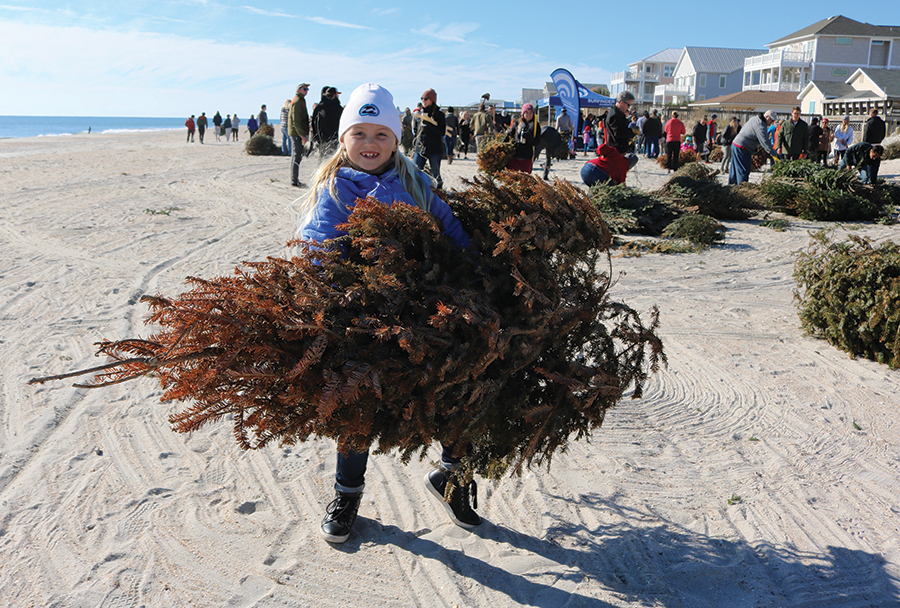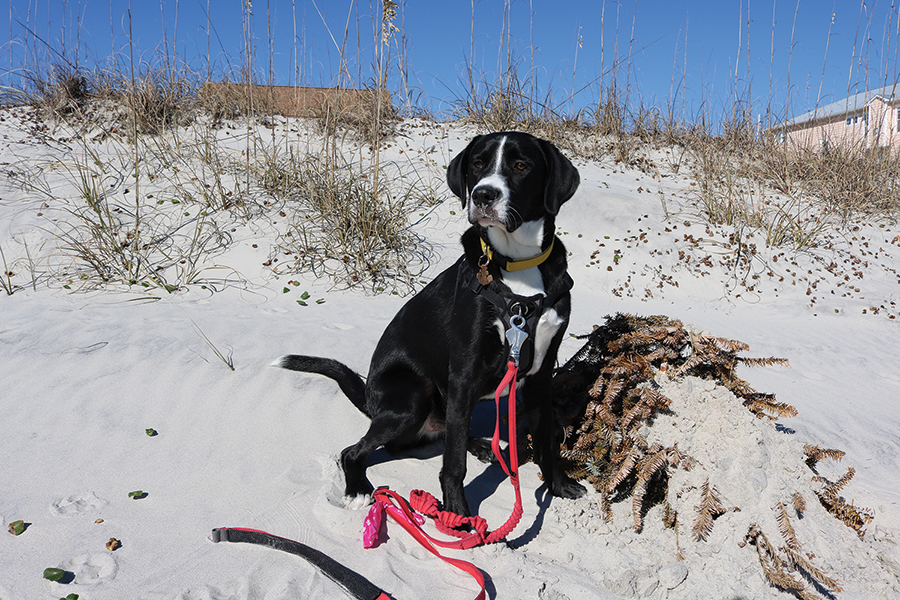The Surfrider Foundation and the town of Carolina Beach team up to prevent beach erosion — with recycled Christmas trees
Story & Photographs By Virginia Holman
I am always a bit wistful come January. The holidays are over. I write the wrong year on my checks. That Mediterranean-vegan-paleo-raw-juice diet proves no match for my chocolate craving. Then there’s the task that I always put off — taking down the Christmas tree. After weeks of basking in the glow of tiny twinkling fairy lights, the thought of packing up my favorite ornaments and toting my shedding evergreen to the curb is as cheery a task as scraping the Thanksgiving plates.
If you happen to live in Carolina Beach, you may not know that discarded Christmas trees are used to help a valuable part of the local landscape — our dune field.
Though most of us think of sand dunes as a beautiful feature that’s nice to have, Kevin Piacenza, chair of Cape Fear Surfrider, says that a dune field is one of the best indicators of a healthy and functioning beach system. “Dunes help prevent surge and tidal flooding,” he says. “Though it’s tempting to think of dunes as a wall that keeps water ‘in its place,’ a field of dunes functions less like a barrier and more like a diffuser.”
That’s because a dune field blocks some of the water with the dune face, and lets some in between the dunes. In this way, he says, the field helps reduce surge by “dispersing wave energy over a large area.” Without dunes, storm surge barrels forward unobstructed and with tremendous force, often toward structures built by humans.
The Cape Fear chapter of the Surfrider Foundation and the town of Carolina Beach have worked together since 2011 to reuse the Christmas trees collected by the town to help sustain and expand the protective dune field. Mayor LeAnn Pierce says that the town works with Surfrider “to find an area of the beach that could use some help. Those dunes help protect our town’s infrastructure from storms, and this project has been very successful.” The town arranges for curbside pickup of the trees and also obtains the necessary permissions from the North Carolina Division of Coastal Management (CAMA) for tree installation.


Longtime Carolina Beach resident Ethan Crouch credits a member of the volunteer group Island Women with setting this project in motion. “The state park at Fort Fisher was using Christmas trees on the beach there,” says Crouch. “She knew I volunteered with Surfrider and suggested that a similar Christmas tree initiative for our town would be a great project.”
Crouch says that Surfrider does a lot of coastal activism: “We work for policies that will help protect our coasts. We’re also all about getting people to experience the coastal resources that we have. Hopefully, when people experience and learn more about our wonderful coast, they are inspired to protect it. We host events that build community spirit and goodwill, and for us, that means getting people out to experience our beaches.”
The Christmas tree project does just that. Each year in mid-January, friends and families gather to “plant the trees.” Surfrider provides a brief educational presentation on dunes, Wake and Bake fortifies volunteers with free coffee and doughnuts, and then the volunteers get to work. Each year, trees are used in areas that show high levels of dune erosion and escarpment. Volunteers install the trees sideways and at a precise angle to increase sand capture. According to Crouch, this involves “sticking the trunk of the tree into the edge of the dune, then tacking the tree down with an untreated wooden stake and hemp twine to help secure that tree to the spot.”


Ten feet later, another tree is installed. Says Crouch: “As the sand blows down the beach, the trees act as a natural sand capture. As the needles and small branches collect the sand, the trees start to bury themselves. Soon, there’s this exponential growth rate because as the trees start to grab sand, a dune begins to build up. Over many weeks the dunes gets bigger, and you get those sweeping sand drifts and valleys. It’s really neat.”
Crouch says that sometimes people read about the event and show up with their Christmas tree in hand. Though that’s a fun idea, the trees that Surfrider uses must be collected and selected by the town. “We can’t use trees with tinsel or other artificial elements,” Crouch says. “We also have planned how many trees we will use, and the town delivers them to the install site.” So if you show up with a tree in hand, be prepared to carry it back home. (A winter bonfire/marshmallow roast is always nice.)
The Surfrider Foundation hosts a variety of volunteer and community events throughout the year. These include planting sea oats on the dunes to help stabilize them, working on community rain gardens to help educate people about the dangers of stormwater pollution, and a very popular annual bodysurfing contest called the Whomparama, which is just plain fun for the community.
And Kevin Piacenza and Ethan Crouch remind us of something that we often forget: The beach belongs to all of us, and it’s up to us to protect it by building community, protecting our waterways, and educating people about this dynamic area.
This year’s Christmas tree event in Carolina Beach will be on Jan. 25 at 11 a.m. See Cape Fear Surfrider’s Facebook page for more information.
Author and creative writing instructor Virginia Holman lives and writes in Carolina Beach.

